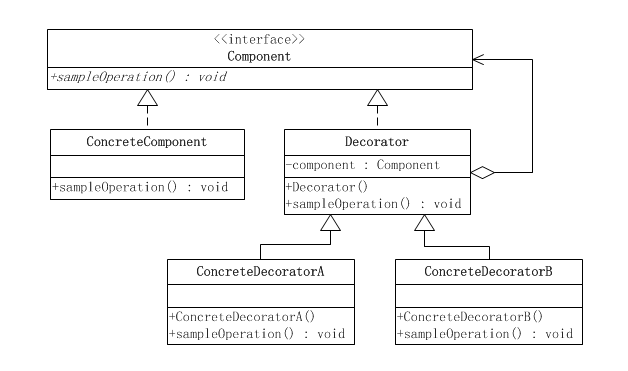|
装饰者模式目标
把许多要实现的功能,加载在子类上,类的继承,显得很臃肿,装饰着模式是在不改变原有类文件和使用继承的情况下,通过创建一个包装对象动态地扩展一个对象的功能,相比生成子类更为灵活
装饰模式的结构
在装饰模式中的角色有:
● 抽象构件(Component)角色:给出一个抽象接口,以规范准备接收附加责任的对象。
● 具体构件(ConcreteComponent)角色:定义一个将要接收附加责任的类。
● 装饰(Decorator)角色:持有一个构件(Component)对象的实例,并定义一个与抽象构件接口一致的接口。
● 具体装饰(ConcreteDecorator)角色:负责给构件对象“贴上”附加的责任
源代码
抽象构件角色
[Java] 纯文本查看 复制代码
|
1
2
3
4
5
|
public interface Component {
public void sampleOperation();
}
|
具体构件角色
[Java] 纯文本查看 复制代码
|
1
2
3
4
5
6
7
8
|
public class ConcreteComponent implements Component {
@Override
public void sampleOperation() {
}
}
|
装饰角色
[Java] 纯文本查看 复制代码
|
01
02
03
04
05
06
07
08
09
10
11
12
13
14
|
public class Decorator implements Component{
private Component component;
public Decorator(Component component){
this.component = component;
}
@Override
public void sampleOperation() {
component.sampleOperation();
}
}
|
具体装饰角色
[Java] 纯文本查看 复制代码
|
01
02
03
04
05
06
07
08
09
10
11
12
|
public class ConcreteDecoratorA extends Decorator {
public ConcreteDecoratorA(Component component) {
super(component);
}
@Override
public void sampleOperation() {
super.sampleOperation();
}
}
|
[Java] 纯文本查看 复制代码
|
01
02
03
04
05
06
07
08
09
10
11
12
|
public class ConcreteDecoratorB extends Decorator {
public ConcreteDecoratorB(Component component) {
super(component);
}
@Override
public void sampleOperation() {
super.sampleOperation();
}
}
|
齐天大圣的例子
孙悟空有七十二般变化,他的每一种变化都给他带来一种附加的本领。他变成鱼儿时,就可以到水里游泳;他变成鸟儿时,就可以在天上飞行。
本例中,Component的角色便由鼎鼎大名的齐天大圣扮演;ConcreteComponent的角色属于大圣的本尊,就是猢狲本人;Decorator的角色由大圣的七十二变扮演。而ConcreteDecorator的角色便是鱼儿、鸟儿等七十二般变化
源代码
抽象构件角色“齐天大圣”接口定义了一个move()方法,这是所有的具体构件类和装饰类必须实现的。
[Java] 纯文本查看 复制代码
|
1
2
3
4
5
|
public interface TheGreatestSage {
public void move();
}
|
具体构件角色“大圣本尊”猢狲类
[Java] 纯文本查看 复制代码
|
1
2
3
4
5
6
7
8
9
|
public class Monkey implements TheGreatestSage {
@Override
public void move() {
System.out.println("Monkey Move");
}
}
|
抽象装饰角色“七十二变”
[AppleScript] 纯文本查看 复制代码
|
01
02
03
04
05
06
07
08
09
10
11
12
13
|
public class Change implements TheGreatestSage {
private TheGreatestSage sage;
public Change(TheGreatestSage sage){
this.sage = sage;
}
@Override
public void move() {
// 代码
sage.move();
}
}
|
具体装饰角色“鱼儿”
[Java] 纯文本查看 复制代码
|
01
02
03
04
05
06
07
08
09
10
11
12
|
public class Fish extends Change {
public Fish(TheGreatestSage sage) {
super(sage);
}
@Override
public void move() {
System.out.println("Fish Move");
}
}
|
具体装饰角色“鸟儿”
[Java] 纯文本查看 复制代码
|
01
02
03
04
05
06
07
08
09
10
11
12
|
public class Bird extends Change {
public Bird(TheGreatestSage sage) {
super(sage);
}
@Override
public void move() {
System.out.println("Bird Move");
}
}
|
客户端类
[Java] 纯文本查看 复制代码
|
01
02
03
04
05
06
07
08
09
10
11
12
13
|
public class Client {
public static void main(String[] args) {
TheGreatestSage sage = new Monkey();
TheGreatestSage bird = new Bird(sage);
TheGreatestSage fish = new Fish(bird);
fish.move();
}
}
|
“大圣本尊”是ConcreteComponent类,而“鸟儿”、“鱼儿”是装饰类。要装饰的是“大圣本尊”,也即“猢狲”实例。
上面的例子中,系统把大圣从一只猢狲装饰成了一只鸟儿(把鸟儿的功能加到了猢狲身上),然后又把鸟儿装饰成了一条鱼儿(把鱼儿的功能加到了猢狲+鸟儿身上,得到了猢狲+鸟儿+鱼儿)。
如上图所示,大圣的变化首先将鸟儿的功能附加到了猢狲身上,然后又将鱼儿的功能附加到猢狲+鸟儿身上。
设计模式在JAVA I/O库中的应用
装饰模式在Java语言中的最著名的应用莫过于Java I/O标准库的设计了。
由于Java I/O库需要很多性能的各种组合,如果这些性能都是用继承的方法实现的,那么每一种组合都需要一个类,这样就会造成大量性能重复的类出现。而如果采用装饰模式,那么类的数目就会大大减少,性能的重复也可以减至最少。因此装饰模式是Java I/O库的基本模式。
Java I/O库的对象结构图如下,由于Java I/O的对象众多,因此只画出InputStream的部分。
根据上图可以看出:
● 抽象构件(Component)角色:由InputStream扮演。这是一个抽象类,为各种子类型提供统一的接口。
● 具体构件(ConcreteComponent)角色:由ByteArrayInputStream、FileInputStream、PipedInputStream、StringBufferInputStream等类扮演。它们实现了抽象构件角色所规定的接口。
● 抽象装饰(Decorator)角色:由FilterInputStream扮演。它实现了InputStream所规定的接口。
|